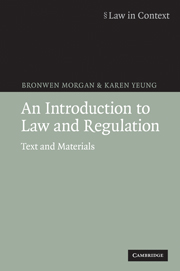2 - Theories of regulation
Published online by Cambridge University Press: 05 June 2012
Summary
Introduction
A theory of regulation is a set of propositions or hypotheses about why regulation emerges, which actors contribute to that emergence and typical patterns of interaction between regulatory actors. In answering the ‘why’ question, we range beyond law to other disciplines, and much of the material in this chapter draws upon the disciplines of politics, economics and sociology. In order to understand the academic literature on this topic, it is helpful to bear in mind two core ideas, which help to differentiate the focus of theories of regulation. Firstly, some theories assume a relatively clear dividing line between public and private actors and institutions while others view the line as blurred both in theory and practice. Secondly, some theories focus mainly on economically defined goals, factors and influences, while others supplement this focus with attention to more broadly defined political goals, factors and influences. Somewhat less attention has been paid to the kinds of values and concerns which lawyers tend to emphasise in exploring the patterned emergence of regulation. The aims of this chapter are therefore twofold. Firstly, to guide the reader through the different theories of regulation, drawing out the contrasts between the roles they give to public and private actors and institutions, and the degree to which they incorporate efficiency-enhancing, redistributive and other broader social objectives. Secondly, to consider the facilitative role of law in theories of regulation and to introduce (within that role) the image of law as umpire.
- Type
- Chapter
- Information
- An Introduction to Law and RegulationText and Materials, pp. 16 - 78Publisher: Cambridge University PressPrint publication year: 2007

